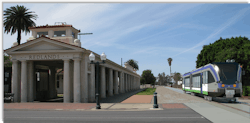The San Bernardino County Transportation Authority (SBCTA) is tasked with improving the transit options in the northern Inland Empire region of Southern California. The area, located in the eastern end of the Los Angeles basin, is home to some of the most economically disadvantaged communities in the state. The implementation of a new rail transit service with the construction of the Redlands Passenger Rail Project (RPRP) takes advantage of an existing but underutilized railroad line originally constructed in 1888.
In its heyday, the Santa Fe Railway served the region’s rapidly growing population and citrus economy. The line was also famous for being part of the “Kite Shaped Route” — a major tourist attraction in the early years of the last century. Changing times and public tastes resulted in the last passenger train operating in 1938. In the 1970s and 1980s, the area was hit hard by the closure of the Santa Fe Railway shops and Norton Air Force Base, as well as by the reduction of citrus packing houses from more than 40 packing facilities to a single survivor in Redlands. What had once been a busy route saw fewer and fewer trains, until only a once-a-week freight service remained and the owner began looking for a buyer.
Planning for Future Growth
In 1992, SBCTA acquired the railroad right of way as part of a plan to establish a passenger rail network throughout Southern California. The new services were proposed to increase mobility while helping to revitalize the communities along the tracks. The San Bernardino to Redlands line became the subject of several preliminary studies on how to best utilize the latent economic potential of the line for improved mobility and reduced traffic congestion for the people of the local communities. The RPRP was the result of these studies, with its goal the development and implementation of a modern, safe and reliable passenger rail transit system to connect the east valley with the rest of the region.
The new 9-mile rail service between the cities of San Bernardino and Redlands will provide thousands of residents in San Bernardino County with an environmentally sustainable mode of transportation that is safe, easy to use and offers reliable access to employment, education and health care centers, as well as retail, entertainment and cultural enrichment opportunities. Benefits will accrue to 41 disadvantaged communities in the cities of Loma Linda, Redlands and San Bernardino, and the increased goods movement opportunities will provide another incentive for industry to move into the area, spurring employment and economic growth for both existing and new residents.
San Bernardino County's population is projected to grow by 25 percent in the next 20 years. With such rapid population growth comes the increased demand for additional transportation services. The RPRP represents a regional commitment to address current and future transportation needs, while simultaneously achieving the regional and state goals to reduce greenhouse gases. The overall purpose of the RPRP is to provide a cost-effective and sustainable travel option for communities situated along the Redlands Corridor in a way that improves transit mobility and reduces travel times, while minimizing adverse environmental impacts.
The Arrow
The RPRP will reconstruct and improve the existing track to allow passenger trains to travel the 9 miles in under 20 minutes (with station stops) at an average speed of 35 mph. The project will also extend centralized traffic control (CTC) and positive train control (PTC) coverage to the corridor, which, when combined with new passing and storage sidings, will provide expanded train capacity. Facilities will include the construction of an equipment maintenance facility and development of four new passenger rail stations. The infrastructure improvement also includes the replacement of five railroad bridges, implementation of quiet zone safety improvements at 23 grade crossings, and the introduction of bike paths to connect the stations with the surrounding neighborhoods.
The funding for the $290 million project is from a mix of local, state and federal resources. Primary funding is from SBCTA’s 1/2-cent Measure I sales tax, supplemented by funding from the California Traffic Congestion Relief Program and Federal Congestion Mitigation and Air Quality Improvement Program, as well as by a Transportation Investment Generating Economic Recovery grant. SBCTA had originally planned to develop the project without federal financial support, but took a conservative approach and followed federal guidelines throughout the project environmental and design phases. Thus, when the opportunity to revamp the funding model to make better use of local match funding opportunities arose, SBCTA was ready to federalize the project. SBCTA is now in the process of pursuing a Federal Transit Administration Small Starts Grant for the RPRP. The grant application process was started in October 2016 with the approval to enter Project Development. The completed rating package was submitted in August of 2017 with an anticipated rating in late 2017. At the same time, SBCTA has requested a Letter of No Prejudice to accelerate the delivery timeline of the passenger vehicles.
SBCTA is looking to be a leader in green passenger transportation. The technology selected for the RPRP was modern hybrid commuter vehicles (HCV), a mix of light rail and mainline passenger rail engineering. Before settling on HCV technology, SBCTA investigated the use of rapid charging super capacitors, currently in use in China, and a number of battery-powered vehicles. Especially interesting was the hydrogen fuel cell passenger coaches that recently entered demonstration service in Germany. Each of these rapidly developing technologies are not yet ready for use in the demanding North American rail environment, but it is only a matter of time, perhaps as soon as a few years from now. Thus, the initial three cars will be equipped with the latest Tier 4 emission technology, while including provisions for later conversion to even lower — possibly even zero — emissions power sources as even more green propulsion systems become available.
SBCTA’s partner for the operation and maintenance of the RPRP trains is Omnitrans, the transit service provider in the valley portions of San Bernardino County. Southern California Regional Rail Authority (SCRRA) will continue to provide dispatching and maintenance of way for the line. In addition, SCRRA will take the lead on the design, implementation and maintenance of the CTC and PTC systems. The Omnitrans service will be operated as the “Arrow,” an homage to the Native American heritage of the region. Omnitrans plans for a frequent-headway commuter service operating on 30-minute peak period and 60-minute off-peak service, augmented by a limited number of Metrolink conventional express trains providing single seat access to its six-county region-wide network.
There is the potential for high ridership as the redevelopment that follows a transit line occurs. The SBTC will provide connectivity to sbX, a 15-mile rapid transit bus service, and six bus transit services throughout San Bernardino and Riverside counties. Both the SBTC and Downtown Redlands stations are adjacent to employment, entertainment and retail land uses. The eastern terminus of the route is at the educational resource of the University of Redlands, where the Arrow will provide new transit access to the students and faculty. An indicator of the strong local commitment to transit is the midpoint New York Street Station; Esri software, whose work headquarters is a short walk from the line, is fully funding the construction and maintenance of this station. Both the University of Redlands and Esri have purchased land surrounding the two stations with plans for future transit-oriented developments.
Ultimately, the RPRP is on schedule to begin Arrow revenue service in late 2020. The implementation of this state-of-the-art, innovative passenger service will result in a greatly needed transportation alternative that will, in turn, improve economic opportunities, enhance employment and lead to an overall better quality of life for the residents of San Bernardino County and beyond.
Carrie Schindler is the director of transit and rail and Justin Fornelli is the chief of transit and rail programs at SBCTA.




